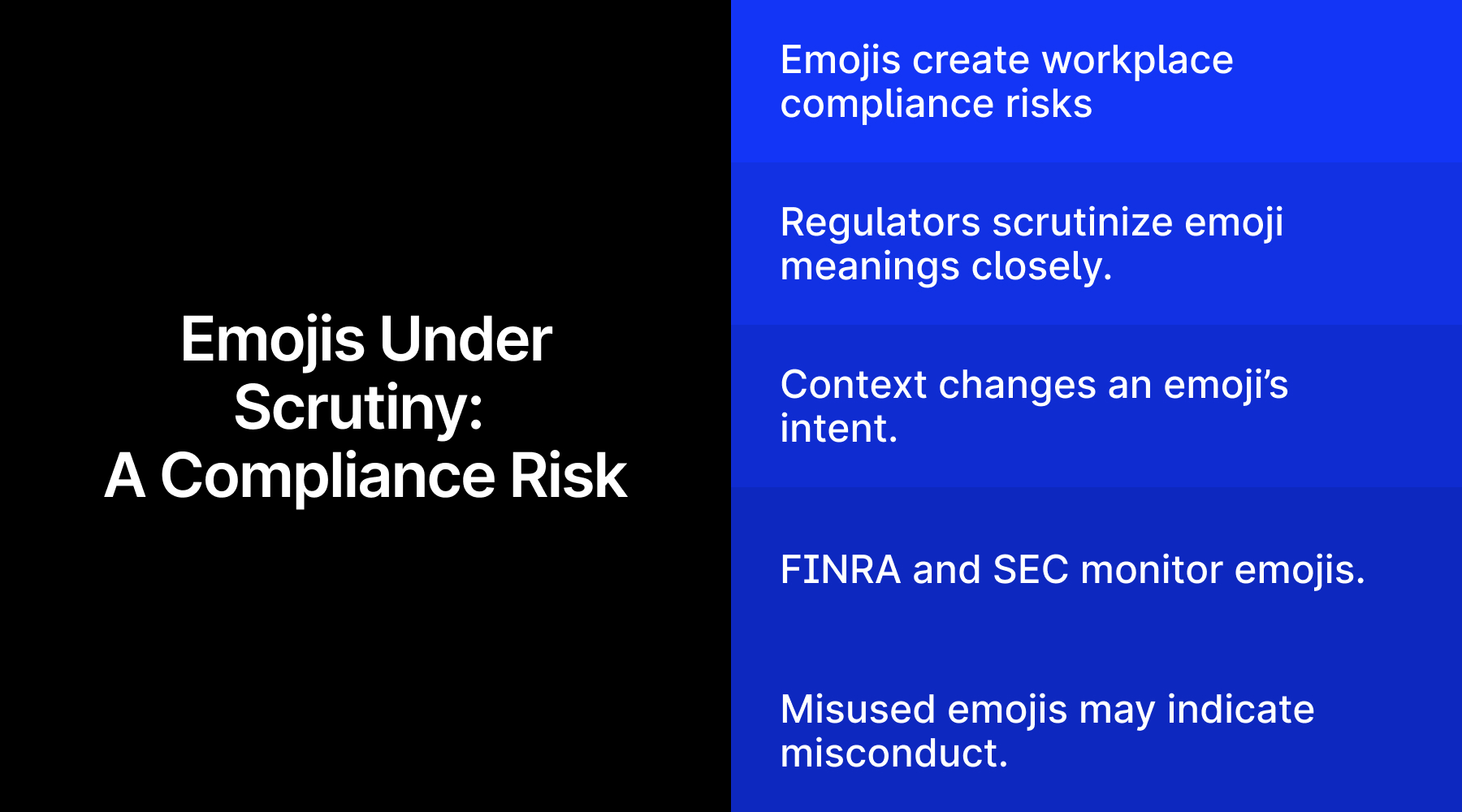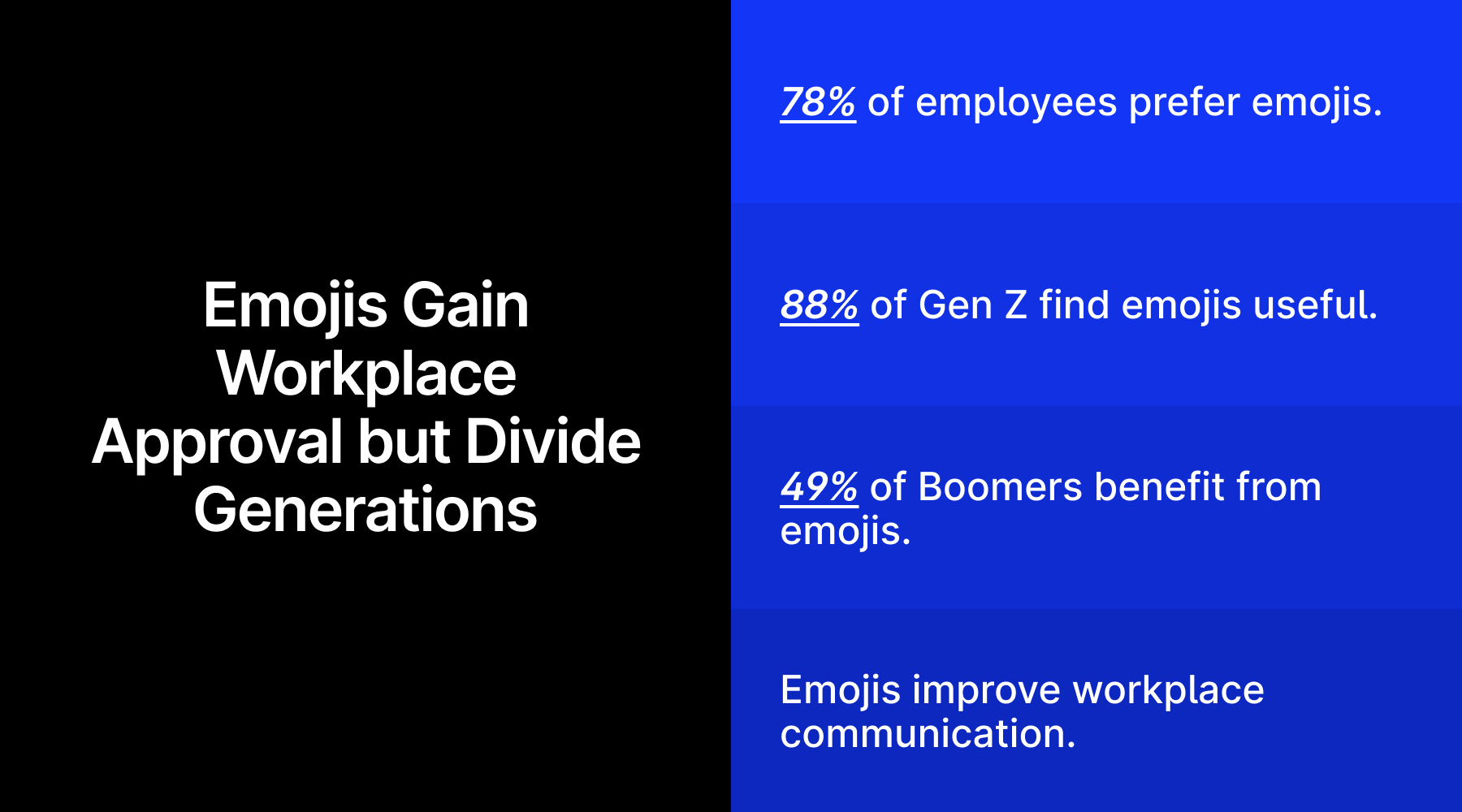Once a playful addition to messages, emojis have become a
essential in workplace communication across platforms like Slack, Teams, SMS, and
email. While they may seem harmless, they pose compliance risks that many firms
are not equipped to handle.
Regulators now scrutinize every “thumbs up” 👍,
“fire” 🔥, and “crying laughing” 😂,
recognizing their potential implications. Since their meaning depends on
context, the sender, and even the recipient’s mood, compliance teams must adapt
to this evolving communication style.
🚦 Why Emojis Are a
Compliance Issue
Workplace conversations have become shorter and more
emoji-filled, catching the attention of regulators. Inappropriate emoji use can
blur professional boundaries, create risks, or even indicate potential
misconduct.
A “winking face” 😉, for example, can be
perceived as friendly or inappropriate, depending on the context. Traders using
“rocket” 🚀 and “moon” 🌕 might simply be
expressing enthusiasm, or they could be attempting to mislead investors. Some
have even used emojis as coded signals to communicate secretly.
Regulators such as FINRA and the SEC have taken notice. In
2023, a judge ruled that a company provided investment advice using emojis on
Twitter, setting a precedent for greater regulatory scrutiny. Ignoring emojis
is no longer an option. Like a boxer in silk gloves, they may seem light but
can deliver a powerful impact.

🤷♂️ The Challenge: Emojis Are Subjective
Tracking emoji usage is not enough—understanding intent is
crucial. The same emoji can carry different meanings depending on the context.
For instance, a “fire” 🔥 emoji might mean “great
job” in a team chat but could suggest something far riskier in a financial
setting. A “skull” 💀 may indicate disaster
to one person but embarrassment to another, especially among younger employees.
Similarly, a “check mark” ✔️ could mean approval or simply
that a message was seen.
Manually interpreting emojis across thousands—or even
millions—of workplace messages is impractical for compliance teams. Without
proper oversight, emojis can lead to misunderstandings, misinterpretations, and
even compliance violations.
📱 Emojis as a
Productivity Tool
Despite compliance concerns, emojis can actually enhance
workplace communication. A study by Atlassian found that 65% of employees use
emojis to improve clarity in messages.
The same study revealed that 78% of employees are more
likely to open and read messages containing emojis, while 88% of Gen Z workers
found emojis useful compared to just 49% of Boomers. This suggests that emojis
can make workplace communication more engaging and effective, but only if used
responsibly.

For some, emojis bring clarity and emotion to conversations.
For others, they create confusion and potential risks. The challenge lies in
setting clear guidelines to ensure proper usage.
You may find it interesting: WhatsApp
Compliance: Self-Reporting Drives Regulatory Change Initiation.
💡 Best Practices for
Managing Emojis
Since banning emojis isn’t realistic, organizations should
implement clear rules to manage their use.
🚫 Define Acceptable Use:
Some emojis, like the “eggplant” 🍆, carry obvious risks.
Employers should establish guidelines on which emojis are acceptable in
professional communication.
📚 Train Employees:
Encourage responsible emoji use to prevent misunderstandings and ensure
compliance. Employees should be aware that emojis, like words, can be
misinterpreted.
📊 Use Compliance Tools:
Advanced technology can analyze emoji usage, helping compliance teams identify
potential risks while allowing for efficient communication.
🤖 Leveraging
Technology for Smarter Compliance
Modern compliance tools can help organizations monitor
emojis more effectively by providing greater context.
Instead of flagging emojis in isolation, these solutions
analyze them within full conversation threads, making it easier to determine
intent. They can also track engagement, capturing not just emojis used in
messages but also those sent as reactions, like “thumbs up” 👍
or “crying laughing” 😂.
As regulations continue to change, compliance technology can
adapt to ensure that businesses remain compliant. These tools can capture
emojis, GIFs, and other digital shorthand, helping organizations navigate the
complexities of modern workplace communication.
🔮 The Future of Emoji
Compliance
As workplace communication evolves, regulators are paying
closer attention to how emojis are used. Rather than struggling with manual
oversight, businesses should leverage compliance technology to accurately
interpret and flag digital intent.
By proactively addressing emoji-related risks, organizations
can maintain compliance while fostering a modern, efficient communication
culture. This approach ensures that employees—whether Boomers or Gen Z—can
interact professionally and productively while staying within regulatory
guidelines.
Once a playful addition to messages, emojis have become a
essential in workplace communication across platforms like Slack, Teams, SMS, and
email. While they may seem harmless, they pose compliance risks that many firms
are not equipped to handle.
Regulators now scrutinize every “thumbs up” 👍,
“fire” 🔥, and “crying laughing” 😂,
recognizing their potential implications. Since their meaning depends on
context, the sender, and even the recipient’s mood, compliance teams must adapt
to this evolving communication style.
🚦 Why Emojis Are a
Compliance Issue
Workplace conversations have become shorter and more
emoji-filled, catching the attention of regulators. Inappropriate emoji use can
blur professional boundaries, create risks, or even indicate potential
misconduct.
A “winking face” 😉, for example, can be
perceived as friendly or inappropriate, depending on the context. Traders using
“rocket” 🚀 and “moon” 🌕 might simply be
expressing enthusiasm, or they could be attempting to mislead investors. Some
have even used emojis as coded signals to communicate secretly.
Regulators such as FINRA and the SEC have taken notice. In
2023, a judge ruled that a company provided investment advice using emojis on
Twitter, setting a precedent for greater regulatory scrutiny. Ignoring emojis
is no longer an option. Like a boxer in silk gloves, they may seem light but
can deliver a powerful impact.

🤷♂️ The Challenge: Emojis Are Subjective
Tracking emoji usage is not enough—understanding intent is
crucial. The same emoji can carry different meanings depending on the context.
For instance, a “fire” 🔥 emoji might mean “great
job” in a team chat but could suggest something far riskier in a financial
setting. A “skull” 💀 may indicate disaster
to one person but embarrassment to another, especially among younger employees.
Similarly, a “check mark” ✔️ could mean approval or simply
that a message was seen.
Manually interpreting emojis across thousands—or even
millions—of workplace messages is impractical for compliance teams. Without
proper oversight, emojis can lead to misunderstandings, misinterpretations, and
even compliance violations.
📱 Emojis as a
Productivity Tool
Despite compliance concerns, emojis can actually enhance
workplace communication. A study by Atlassian found that 65% of employees use
emojis to improve clarity in messages.
The same study revealed that 78% of employees are more
likely to open and read messages containing emojis, while 88% of Gen Z workers
found emojis useful compared to just 49% of Boomers. This suggests that emojis
can make workplace communication more engaging and effective, but only if used
responsibly.

For some, emojis bring clarity and emotion to conversations.
For others, they create confusion and potential risks. The challenge lies in
setting clear guidelines to ensure proper usage.
You may find it interesting: WhatsApp
Compliance: Self-Reporting Drives Regulatory Change Initiation.
💡 Best Practices for
Managing Emojis
Since banning emojis isn’t realistic, organizations should
implement clear rules to manage their use.
🚫 Define Acceptable Use:
Some emojis, like the “eggplant” 🍆, carry obvious risks.
Employers should establish guidelines on which emojis are acceptable in
professional communication.
📚 Train Employees:
Encourage responsible emoji use to prevent misunderstandings and ensure
compliance. Employees should be aware that emojis, like words, can be
misinterpreted.
📊 Use Compliance Tools:
Advanced technology can analyze emoji usage, helping compliance teams identify
potential risks while allowing for efficient communication.
🤖 Leveraging
Technology for Smarter Compliance
Modern compliance tools can help organizations monitor
emojis more effectively by providing greater context.
Instead of flagging emojis in isolation, these solutions
analyze them within full conversation threads, making it easier to determine
intent. They can also track engagement, capturing not just emojis used in
messages but also those sent as reactions, like “thumbs up” 👍
or “crying laughing” 😂.
As regulations continue to change, compliance technology can
adapt to ensure that businesses remain compliant. These tools can capture
emojis, GIFs, and other digital shorthand, helping organizations navigate the
complexities of modern workplace communication.
🔮 The Future of Emoji
Compliance
As workplace communication evolves, regulators are paying
closer attention to how emojis are used. Rather than struggling with manual
oversight, businesses should leverage compliance technology to accurately
interpret and flag digital intent.
By proactively addressing emoji-related risks, organizations
can maintain compliance while fostering a modern, efficient communication
culture. This approach ensures that employees—whether Boomers or Gen Z—can
interact professionally and productively while staying within regulatory
guidelines.
This post is originally published on FINANCEMAGNATES.

